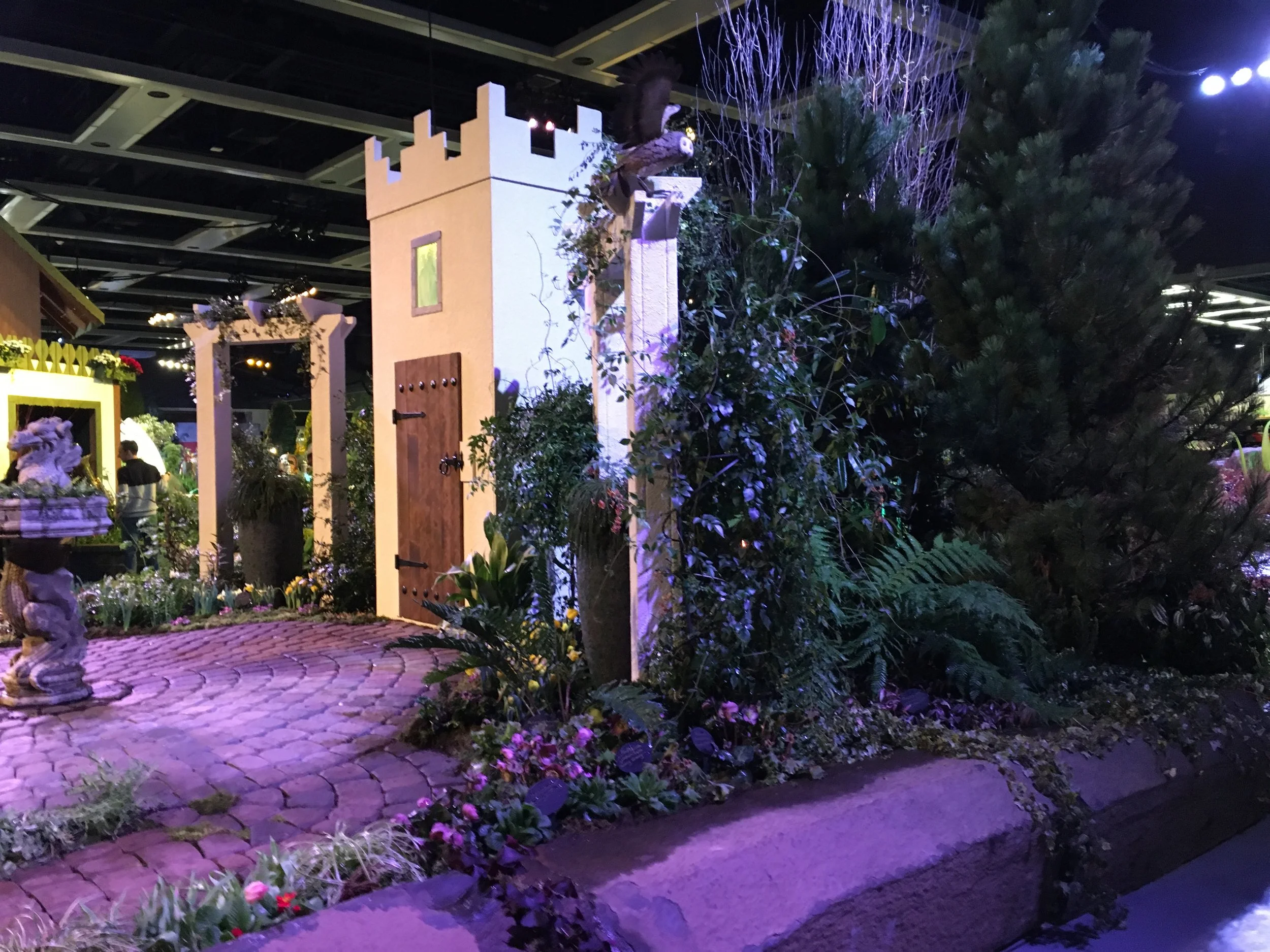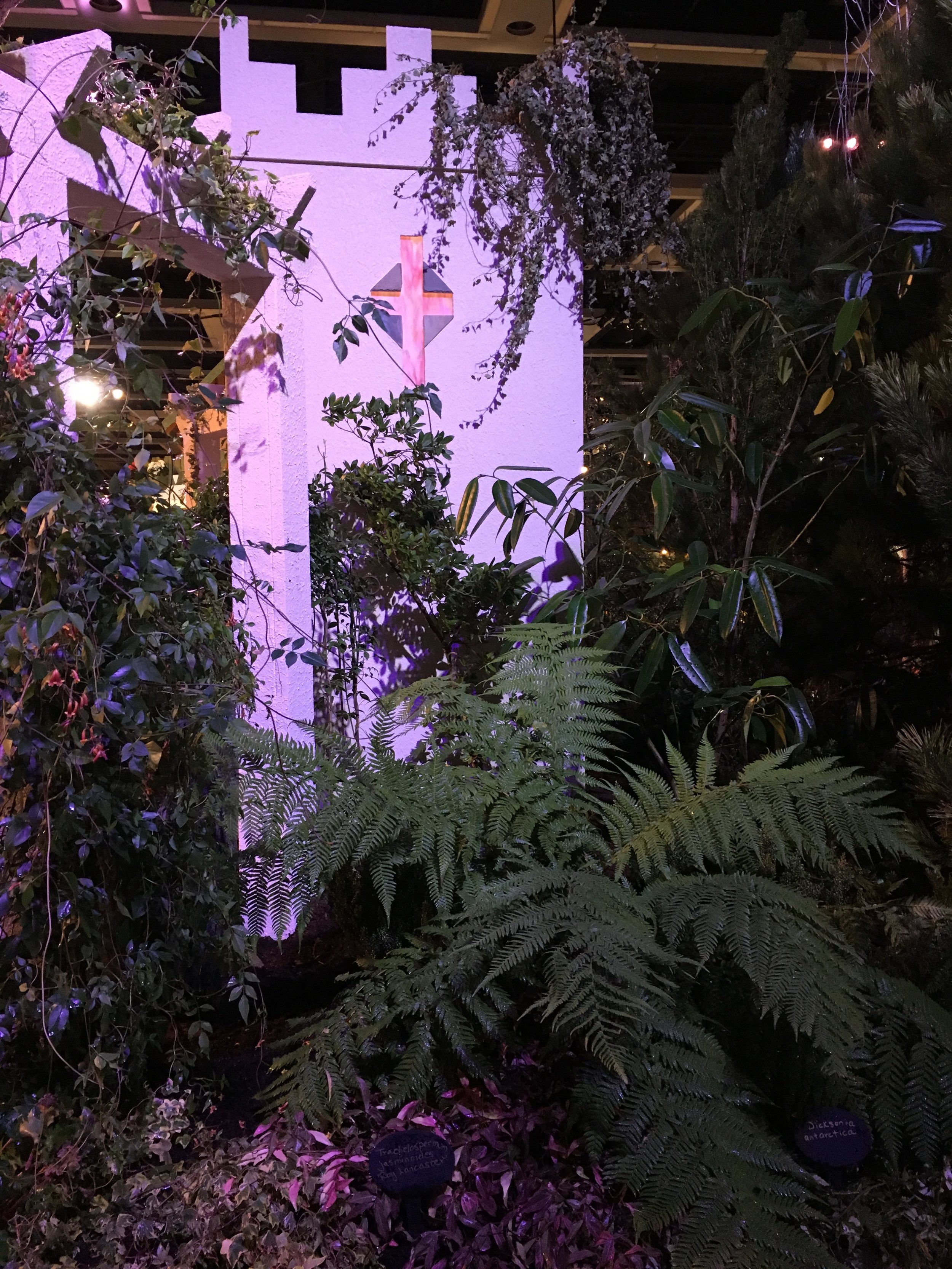



























Our Irish-themed exhibit juxtaposes key elements of the Irish countryside, incorporating a Tower House, a Sacred Stone Circle, a green and gently rolling landscape, and a touch of Irish folklore and mythology. Over 3,000 tower houses still stand in Ireland today, and there are approximately 120 surviving stone circles. These sacred sites, often built around natural springs, utilize a circular layout surrounded by large stone columns. Our tower house is perched on the edge of a sacred henge, flanked by monolithic arbors reminiscent of ancient megalithic architecture.
The majority of Irish tower houses were built between the 10th and 14th centuries as strongholds for local lords, and similar designs were utilized both by Gaelic natives and English invaders. Much simpler than English castles, they are typically stout, square towers several stories tall, meant to provide both accommodation and defense for their residents. Although many are standing in disrepair today, greyed by age, these towers would have originally been whitewashed with limestone rich plaster to protect their stones and mortar, giving them a gleaming white appearance. The heavy wooden door, narrow arrow slits, small, heavily reinforced windows, and stepped crenellations all served a distinct purpose in augmenting the defensive capability of the tower house. Some well-kept tower houses were heavily modified in the 19th century, sprouting massive additions flanking the original tower to convert them into opulent manors. As the need for defense declined, luxurious touches were added to many tower house estates; stained glass windows sealed former arrow slits and iron-grated windows, and large gardens sprung up around them.
Following a traditional method of castle design, these towers were typically constructed on a raised mound of rammed earth or mott, with only one heavily guarded ramp or drawbridge leading in, making large sieges difficult. Below the mott is the bailey, a larger, less heavily fortified area populated with residences, smithies, bakeries and storehouses. A gently curving path rolls down the rolling green hillside from our sacred stone circle mott, separated from the bailey by an iron gate.
Down in the bailey outside the gate our garden gives way to a land steeped in a rich folkloric tradition, where giants, faeries and pucas (leprechaun-like creatures) roam the landscape. A pair of large willow chairs, seemingly made for harp-playing Guinness-swilling giants, guard the entrance gate, while a meandering greenstone path leads away to the house of a local puca (or leprechaun). Mischievous in nature, pucas can be extremely helpful if treated well, but this requires frequent offerings of bread and milk. An unhappy puca can be a serious detriment to any Irish household, causing no end of ruin and chaos! Our puca is productive and well cared for, with his own cottage, small spring-fed pond, and a primrose rainbow emanating from his carefully guarded pot of gold. Lush, subtropical foliage surrounds his cottage, sheltered from cold winter temperatures by the Gulf Stream current and a little touch of magic. Behind the puca’s cottage, a tall, swirling fairy air-traffic control tower is circled by pixie delivery planes, as they come and go trading nectar and ambrosia in exchange for the puca’s homemade beer, whiskey and potatoes.
Ireland conjures up rolling fields of green, accented by white limestone cliffs and stones. Throughout the year the lush, flowing landscape is punctuated by seas of yellow wildflowers. Our color palette reflects this, utilizing large swaths of green, gently descending from the tower house, accented with variegated foliage and yellow blooms. Ireland is temperate, so most of the garden is filled with hardy plant material found in the Emerald Isle, including clover, yews, camelias, pines, spike-moss, primroses, tulips, ferns, daffodils, euonymus, grasses, heather, lavender, boxwood, ivies and holly relatives. Just like Cornwall in England, though, much of Southern Ireland is protected by the Gulf Stream current, making it possible to grow a wealth of sub-tropical plants despite the latitude. These tender perennials are concentrated around the puca’s house, bolstered by his diligent and magical care, including hibiscus, abutilons, boston ferns, begonias, and acanthus. Tender and unusual vine specimens, including an orange-blossomed pandoria and variegated jasmines, flank the monolithic arbors, as well as a large Tasmanian tree fern specimen.
Our garden combines physical features of the present and past Irish landscape with a touch of folklore and mythology to really capture the essence of Ireland. Rolling green hills, castle-like tower houses, and sacred stone circles, springs, and monolithic relics of the Emerald Isle’s distant past are all represented in unity, with a distinct nod to the legends of faeries, pucas, giants and other mysterious and powerful beings that are central to Ireland’s rich culture.
Take-home ideas:
*Combining multiple physical elements of a country’s landscape into one unified design can effectively capture the essence of a place
*Our garden is very practical and achievable. It was assembled by two 70+ year old women, two 34 year old men, one dedicated 33 year old assistant, and several part time volunteers. We do not have contractors or a large crew. You don’t have to build a stone castle to enjoy a touch of whimsy in your garden or everyday life. The tower and arbors are constructed of simple materials available at any hardware store (plywood, timber, stone texture paint, tile), and was designed, built and erected by two people who are not expert carpenters!
Welcome to Fancy Fronds Nursery! We are a small family run business located in Gold Bar, Washington, specializing in garden ferns for all occasions and growing zones in the U.S. Our nursery is open year-round by appointment, and a wide selection of plants are available for spring and fall shipping. Find the fern that's right for you!
Powered by Squarespace